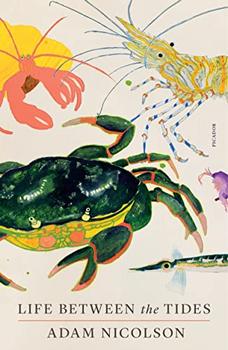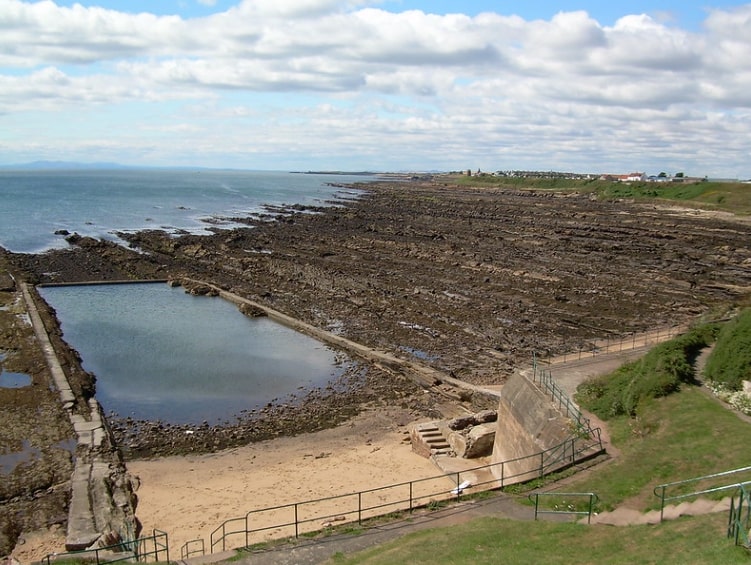Summary | Excerpt | Reviews | Beyond the Book | Read-Alikes | Genres & Themes | Author Bio

This article relates to Life Between the Tides
 Tidal pools are pockets of saltwater that exist in the intertidal zone — the area in which the ocean meets the land. They are formed due to the gravitational pull of the moon and the sun, as well as the centrifugal pull of the Earth as it turns, which draws the water in gentle waves around the globe. Tides vary around the world based on the contours of the land and are categorized into three different types determined by the shape of the coastline and location: (1) diurnal, where there is just one high and one low tide daily; (2) semi-diurnal, where there are two matching high and two matching low daily tides; and (3) mixed semi-diurnal, where the two high and two low daily tides are of varying heights. Tides are also categorized in two different ranges based on the orientation of the sun and the moon in relation to the Earth: spring tides, which are higher tidal ranges, and neap tides, which are lower tidal ranges.
Tidal pools are pockets of saltwater that exist in the intertidal zone — the area in which the ocean meets the land. They are formed due to the gravitational pull of the moon and the sun, as well as the centrifugal pull of the Earth as it turns, which draws the water in gentle waves around the globe. Tides vary around the world based on the contours of the land and are categorized into three different types determined by the shape of the coastline and location: (1) diurnal, where there is just one high and one low tide daily; (2) semi-diurnal, where there are two matching high and two matching low daily tides; and (3) mixed semi-diurnal, where the two high and two low daily tides are of varying heights. Tides are also categorized in two different ranges based on the orientation of the sun and the moon in relation to the Earth: spring tides, which are higher tidal ranges, and neap tides, which are lower tidal ranges.
As the tide rises, tidal pools disappear underneath the seawater, drawing in various sea life with the movement of the waves. As the tide falls, pools are formed in depressions in rocky formations near the shore, containing whatever life fell into them or remained clinging tenaciously to the side of the rock while the ocean rose above. Due to the extremes in heat, moisture and wave action from the movement of the tides, organisms commonly found in tidal pools have developed extraordinary means of survival in a staggering variety of forms, from oystercatchers — long-beaked and leggy black and white wader birds — to bladderwrack — a brown seaweed that is currently growing in popularity as a health food.
Most of us probably think of tide pools as the small bodies of water between rocks at the beach, but tide pools can also be large, and sometimes they are manually created, as Adam Nicolson does in Life Between the Tides, by either breaking away at existing rock to create a depression, or by building a wall of sorts that traps the seawater in at high tide and becomes a pool when the tide recedes. It is quite common for tidal pools — both natural and human-made — to be used by people for swimming. They can be found anywhere there are coastlines around the world. Life Between the Tides focuses primarily on Scottish tidal pools — specifically those at Rubha An T-Sasannaich, which is off the Sound of Mull near the Hebrides along the Western coast of Scotland. The area is known for its wild beauty and connection with the sea, as well as its treacherous waves, which gives rise to the rich folklore and cultural history that Nicolson also explores in the book. Archaeological and cultural remains reflect inhabitants' connection with the sea. Middens, or shell heaps, have been discovered that were left behind by people dating back to the Mesolithic Age. Folkloric stories from the region relating to the tides have been transmitted throughout generations, such as the myth of Lady's Rock, in which a royal lady was left stranded by her husband on a rock in the middle of the ocean to die as the tide rose, but somehow managed to escape and exact her vengeance.
A human-made tidal pool used for swimming in Pittenweem, Fife, Scotland, courtesy of Allan McBain via Flickr
Filed under Nature and the Environment
![]() This "beyond the book article" relates to Life Between the Tides. It originally ran in March 2022 and has been updated for the
February 2023 paperback edition.
Go to magazine.
This "beyond the book article" relates to Life Between the Tides. It originally ran in March 2022 and has been updated for the
February 2023 paperback edition.
Go to magazine.
Your guide toexceptional books
BookBrowse seeks out and recommends the best in contemporary fiction and nonfiction—books that not only engage and entertain but also deepen our understanding of ourselves and the world around us.